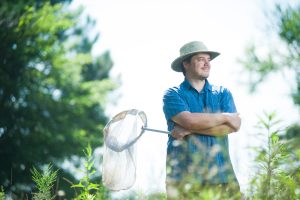
From the Winter 2019 Collegian | Outside of Dr. Jeffrey Lozier’s tent in the mountains of Sequoia National Park, a fresh layer of snow awaits the group of scientists about to embark on their day’s journey. The below-freezing temperatures and few flakes still falling make it difficult to leave the minimal warmth of his polyester shelter, even in layers of heavy clothes. In this cold climate, it’s difficult to remember that it’s the middle of May. There’s nothing remotely resembling a warm spring day.
That is, except the bumblebees buzzing around the early-blooming flowers, as if they were enjoying the sun in the valley 8,000 feet below.
Lozier and Dr. Janna Fierst, both of UA’s department of biological sciences, are working with collaborators at the University of Wyoming and the U.S. Department of Agriculture to test how much, if at all, environmental factors influence the genome of an organism without changing the code itself. And the ever-resilient bumblebee is their perfect test subject.
“Bumblebees are interesting for a number of reasons,” Lozier said. “One of which is that they’ve evolved to be really good at dealing with living in cold environments.”
Bumblebees, Lozier explained, evolved in mountainous regions around 30 or 40 million years ago and, after dispersing from there, retained the ability to survive in cold, high-elevation regions. Flying, as well as shivering, releases heat retained by their large bodies and fur coats, allowing them to fly in freezing temperatures that other animals would not be able to be active.
The particular species of bumblebee that Lozier, Fierst, and their colleagues are studying resides along the west coast, in the valleys of southern California all the way to the Cascade Mountains of Oregon, where the study’s bees are being collected and then kept in Wyoming by a team from the University of Wyoming. And while the species is almost identical throughout the region, those who live in higher elevations are able to survive much colder temperatures than those in lower elevations.
Lozier and his team, through a $2.4 million grant from the National Science Foundation, are investigating why these differences exist—whether the bees have a miniscule difference in their genetic sequence, or if the environment around them has affected their ability to survive.
“Populations from cold environments are actually able to, when you bring them into the lab, withstand much colder temperatures, and the populations from warm environments don’t withstand as low temperature as the high elevation population,” Lozier said. “For this project, we’re zooming in on a subset of populations at low and high elevations. And we’re going to really delve in to figuring out the molecular mechanisms of differences in cold tolerance within a species and what causes that—whether it’s a genetic thing, or whether it’s due to individual experience.”
The National Science Foundation’s Rules of Life grant targets projects like this one—interdisciplinary projects whose ultimate goal is to “allow us to better understand such interactions and identify causal, predictive relationships across these scales: so-called ‘rules’ for how life functions.” Lozier and Fierst’s work challenges those building blocks not only for bumblebees, but for all other species on Earth.
“The research is based around this idea that maybe there’s something in the genome that doesn’t change,” Lozier said. “Something that’s not a mutation necessarily, but some sort of heritable variation that can be passed on from mom to offspring that decides what genes are turned on and off that’s not the actual DNA sequence variation. Understanding this is necessary and important.”
The $2.4 million grant will be divided between the collaborators, with $1.4 allotted specifically for research performed at UA. Here, Fierst will work with post-doctoral, graduate, and undergraduate researchers to create models of the bumblebee’s molecular interactions, unravelling around 13,000 genes per bumblebee observed. By comparing the different genetic codes, Fierst and her team will be able to identify how the genes are being expressed—how the environment is influencing the bees’ gene expression.
One species of bumblebee was declared endangered in the United States in January 2017, but populations of other species may also be dwindling. Lozier and Fierst hope that the research not only helps better explain the building blocks of life, but provides some answers to saving the nation’s bumblebees.
“The evidence suggests that ranges where organisms can live are shrinking for a lot of species, including bumblebees,” Lozier said. “There are many factors influencing this, but it’s suggested that temperature or climate change may have a big impact. That’s the angle that we’re interested in—what about climate change is contributing to these declining ranges and how the changes in the environment affect the range in which bees can survive.”
Over the next four years, Lozier and Fierst, along with their team in Wyoming, plan to look at the genetic codes of hundreds of bumblebees in order to find the balance between environmental influence and genetic makeup.